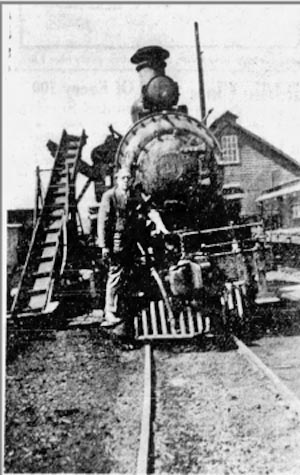
Tweetsie - A Railway Doing "Strip Tease", Published 11 April 1951 My reason for visiting Johnson City, Tennessee, was to ride the Tweetsie. The Tweetsie is a railway, officially known by the long-winded name of East Tennessee and Western North Carolina railroad company. With that long label it operates nine miles of track. The Tweetsie is as little-known in Ottawa as Bowlws lunch is in Johnson City. But the Tweetsie is an amazing railway. It is currently doing a strip tease. Once a transportation system measuring 75.3 miles in all, it has been progressively peeling off miles of track, till today all that is left is the little strip from Johnson City to Elizabethton. It went up into the Carolina Hills originally to Boone. But bad luck and floods plus a depression finally forced the owners to decide to cut off parts of the Railway. The narrow gauge from Cranberry to Boone, a distance of 32 miles, was eliminated. Twisted around curves Until this part of the road was abandoned, the gallant little line twisted around curves that would bother a goat, and crept up four per cent grades that would make any main line operator go crazy. Tweetsie officials were a little vague as to the precise altitude of the railways summit, but it is certain that the road went higher than 4,000 feet. When you consider that the Canadian National at its continental divide, Yellowhead, B. C., only attains 3,717 ft, you know how the Tweetsie once soared. Yet over this big hump went the little narrow gauge, even being so fancy as to haul a parlor car. I have before me, the schedule in effect May 12th, 1930, and it shows the through train with parlor car operating then. It's cute green coaches kept as clean as could be, it's colored and polished engine, and it's chime whistle engine, were part of the mountaineer tradition. First the railway stripped off the line from Cranberry, East, thus depriving the area of rail service. Today everything is trucked in. Then later, bad luck, just before Pearl Harbor, hit the lowest section between Cranberry and Elizabethton. Added Standard Gauge In the beginning, all traffic off the Tweetsie had to be transshipped at Johnson City, because naturally standard gauge box cars cannot run on narrow gauge. So for one reason or another, they added standard gauge from Elizabethton for the last nine miles to Johnson City. Then they moved all the picturesque old narrow-gauge stuff to Elizabethton. But much of the equipment at this exchange point was fitted with special couplers. Thus an engine on standard gauge would have a sort of swivel coupler which would enable it to swing a bit and handle narrow gauge cars. Similarly the little narrow gauge locomotives could move the big standard gauge around. This phenomenon is rare, but when I visited Salida, Colorado, years ago, where the Rio Grande exchange their broad and narrow gauge, the same kind of two-way couplers existed. Well the narrow gauge is a thing of the past. The upper end of the narrow gauge was abandoned before the U. S. got into the war, and it was not deemed wise to restore it. Then the lower end was abandoned. Today, the railway is doing its strip tease. Everyday it is tearing up tracks, pulling down stations, and removing other equipment. The Narrow Gauge section from Cranberry to Elizabethton is becoming history. The last run was made October 12th, 1950. I got a letter since I came back from C. G. Crumley, the conductor, and he sent me some pictures taken when old number 11 made her final passenger trip. Later, on the day I was there, I went over to Elizabethton, and had my picture taken on the now cold, silent, and dead number 11. She will soon be boiled down for scrap unless some Museum wants her. One of most glamorous This by no means is all that can be written about the Tweetsie. Whole chapters in Railway books have been devoted to the Tweetsie. Magazines have sent crack staff men to glorify her past. The Tweetsie was one of the most glamorous of all the slow trains of yesterday. Small Wonder then that I went 1.300 miles to ride her. I climbed aboard a standard witcher No. 205, and we chuffed and huffed and puffed up and down the yard. Engineer Walter Allison, who has been with the railway almost half a century, turned over his throttle to the fireman. He then grabbed the shovel, and between spreading the spuds, kept up a running conversation. To him the folding of the narrow gauge is a tragedy. When they grub up out the old tracks, they are tearing at the very tendrils of his being. When they scratch at the old Tweetsie equipment, they are scrapping a little bit of engineer Allison, of conductor G.G. Crumley, with it.  Dead But Not Gone Here is No. 11, a gallant little narrow gauge engine, all ready to be scrapped. She ran on the Tweetsie in east Tennessee and the mountains of Carolina until they ripped up the tracks. The individual barely discernible on the Tweetsie's cow catcher is The Evening Citizen's Geography Teacher, Austin F. Cross. |
![]()